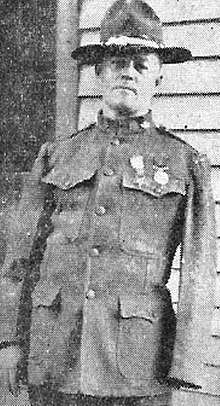Frank Gaffney (Medal of Honor)
Frank Joseph Gaffney (December 18, 1883 – May 25, 1948) was a soldier in the United States Army who received the Medal of Honor for his actions during World War I. He was considered "the second bravest man in the U. S. Army."
Frank J. Gaffney | |
|---|---|
 Medal of Honor recipient | |
| Born | December 18, 1883 Buffalo, New York |
| Died | May 25, 1948 (aged 64) |
| Place of Burial | United German and French Cemetery Buffalo, New York |
| Allegiance | United States of America |
| Service/ | United States Army |
| Rank | Private First Class |
| Unit | Company G, 108th Infantry, 27th Division |
| Battles/wars | World War I |
| Awards | Medal of Honor Purple Heart |
Biography
Gaffney was born December 18, 1883, in Buffalo, New York. He died May 25, 1948, and is buried in United German and French Cemetery Buffalo, New York.[1]
General John J. Pershing said Gaffney's deeds placed him among the top heroes of the war. Similarly, Maj. Gen. John F. O'Ryan, commanding officer of the 27th Division, paid Gaffney high honors. "No man has performed more daring exploits or exercised a bigger influence upon those around him by the gallantry of his conduct."[2] O'Ryan also reportedly called PFC Gaffney "the human hurricane."[3] Gaffney also received the Purple Heart, the British Distinguished Conduct Medal, the French Médaille militaire and Croix de Guerre, the Italian Croce di guerra al merito, the Montenegrin Medal for Military Bravery and the Portuguese Medalha da Cruz de Guerra, Third Class.[4] Gaffney, who was known as "the second bravest man in the U. S. Army," later lost his left arm in fighting at St. Souplet on October 15, 1918.[5]
Medal of Honor citation
Rank and organization: Private First Class, U.S. Army, Company G, 108th Infantry, 27th Division. Place and date: At Ronssoy, France; September 29, 1918. Entered service at: Buffalo, New York. Birth: December 16, 1883; Buffalo, New York. General Orders: War Department, General Orders No. 20 (January 30, 1919).
Citation:
Private First Class Gaffney, an automatic rifleman pushing forward alone with his gun, after all the other members of his squad had been killed, discovered several Germans placing a heavy machinegun in position. He killed the crew, captured the gun, bombed several dugouts and, after killing four more of the enemy with his pistol, held the position until reinforcements came up when 80 prisoners were captured.[6]
Military awards[7][8]
Gaffney's military decorations and awards include:
| 1st row | Medal of Honor | Purple Heart | World War I Victory Medal w/three bronze service stars to denote credit for the Somme Offensive, Ypres-Lys and Defensive Sector battle clasps. | ||||||
|---|---|---|---|---|---|---|---|---|---|
| 2nd row | Distinguished Conduct Medal (Great Britain) | Médaille militaire (French Republic) | Croix de guerre 1914–1918 w/bronze palm (French Republic) | ||||||
| 3rd row | Croce al Merito di Guerra (Italy) | Medal for Military Bravery (Kingdom of Montenegro) | Medalha da Cruz de Guerra, Third Class (Portuguese Republic) | ||||||
See also
References
- "Frank Gaffney". Claim to Fame: Medal of Honor recipients. Find a Grave. Retrieved 2009-07-31.
- World War I Hero Dies from Fall from Porch=2008. Niagara County Historical Society's Bicentennial Moments, Niagara County, New York.
- Maurice J. Swetland and Lilli Swetland, These Men: "For Conspicuous Bravery Above and Beyond the Call of Duty …" (Harrisburg, PA: Telegraph Press, 1940), 232.
- John F. O'Ryan, The Story of the 27th Division (Albany: Wynkoop Hallenbeck Crawford Co., 1921).
- Daniel J. Sweeney, History of Buffalo and Erie County 1914-1919, 2nd ed. (Buffalo: Committee of One Hundred Under Authority of the City of Buffalo, 1920), 8, 629.
- "Medal of Honor recipients". Medal of Honor recipients: World War I. Army Center of Military History. June 8, 2009. Retrieved June 8, 2009.
- The Story of the 27th Division by John F. O'Ryan, Appendix C=1921 (PDF). Wynkoop Hallenbeck Crawford Co.,New York. pp. 922, 924, 926–927. Retrieved October 13, 2017.
- "Would We Fight For America Again?", The Los Angeles Times Sunday Magazine=November 11, 1934. The Los Angeles Times, Los Angeles, California. p. 9. Retrieved October 13, 2017.